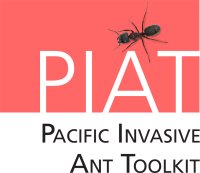Movement controls
Movement controls are used to contain an incursion and prevent invasive species spreading from an infested area.
There are two parts to the containment of ants:
- Restriction of natural spread - preventing ants that have spread to a new area independently (by flight or on foot) from spreading to new areas by removing potential nesting sites and buffer clearance
- Reducing the risk of jump dispersal - ensuring invasive ants are unable to " hitchhike" out of the infested area and establish elsewhere
Both parts involve surveillance. In particular high value areas should be identified and secured.
Restriction of natural spread
Ants typically spread:
- when reproductive females (queens) and males leave the nest in a large group, mate and the mated queens fly to a new location to start a new nest.
- when mated queens ”bud” from their parent nest and walk with a group of workers to form a new nest nearby. This is the way most invasive ants spread naturally.
The most effective way to prevent this natural spread is by a combination of treatment of potential nesting sites, and buffer clearance.
Treatment barriers
Treatment barriers are created by prophylactic baiting using granular, paste or liquid baits complemented by residual sprays. These baits are placed within the infested area and in a buffer zone surrounding it. The radius of the buffer zone is dependent on the ant species present, but a minimum of 50 metres is recommended.
Some treatment examples include:
Granular baits: Antoff® (fipronil based), Amdro® and Maxforce® Complete (hydramethylnon based), Siesta® (metaflumizone based). These baits are spread using a manual spreader within the infested area.
Paste baits: Xstinquish® and Vanquish® Pro (Fipronil based). These baits are applied to cracks and crevices in the infested area and in the surrounding buffer zone.
Liquid baits (for bait stations): Exterm-an ant® (Boric Acid based). These baits are placed inside the infested area at regular intervals and in the surrounding buffer zone.
Residual sprays: Termidor® (fipronil based), Arilon® (indoxacrb based), Deltaforce® (deltamethrin based), Biff® ant, MAXTHOR® and Recruit® (all bifenthrin based). These sprays are applied in the infested area and surrounding buffer zone. The toxicant remains active for a period of several weeks.
Check the treatment options for the most appropriate products for different types of ants.
Buffer clearance
Ensure the area surrounding the infestation (buffer zone) is free from potential nesting sites such as piles of rubbish, stacked timber or disused machinery. Such sites, should be treated with granular bait, paste bait or residual insecticide before movement. After treatment, any materials to be removed from the surrounding area, must first be thoroughly searched by a biosecurity officer for any surviving invasive ants.
Reduce the risk of jump dispersal
The greater risk of spreading ants is via jump-dispersal associated with human transport. The first step required for reducing the risk of jump-dispersal is the identification of the high-risk pathways for transporting ants out of infested areas. Any goods, vehicles or machinery that could harbour invasive ants that are moved from the infested area represent potential pathways for the spread of ants.
You will need to know the answers to the questions:
- What is stored in the area?
- Are there any goods in the area that are routinely moved to other locations (e.g. building supplies, produce, potted plants etc.)?
- Are there vehicles that are parked for long periods of time that are moved occasionally (tractors, boats on trailers, concrete mixers, etc.)?
It is essential that everyone that lives or works in the infested area is made aware of the ant’s presence, informed how the ants spread and required by law to either not remove any materials from the infested area or to submit any materials due for removal from the area for inspection by a biosecurity officer before they may be moved.
The United States Department of Agriculture has federal regulations for transporting high-risk goods from red imported fire ant quarantine areas to different states.
Identify and secure high value areas
When issuing any clearance to move checked items from a high risk (infested) area, it is also important to impose restrictions on where those items can be transported to.
| No movement should be allowed into areas designated as high value, such as wildlife reserves, food storage areas, crop areas or populated areas where ants are likely to establish and cause environmental, agricultural or social problems.
A number of conservation groups implement special measures to ensure invasive species do not invade high value areas. The State of Hawaii, Department of Land and Natural Resources has a video on Biosecurity protocols for protecting the northwestern Hawaiian islands. Tiritiri Matangi Island Sanctuary uses a warrant (© Crown, CC BY 3.0 NZ) to ensure all tourism operators meet minimum standards to operate, and uses posters (© Crown, CC BY 3.0 NZ) to inform visitors of biosecurity risks from the mainland. |

Treasure Islands biosecurity poster (© Treasure Islands, CC BY 3.0 NZ) |
content reviewed by Souad Boudjelas, Pacific Invasives Initiative, November 2016
